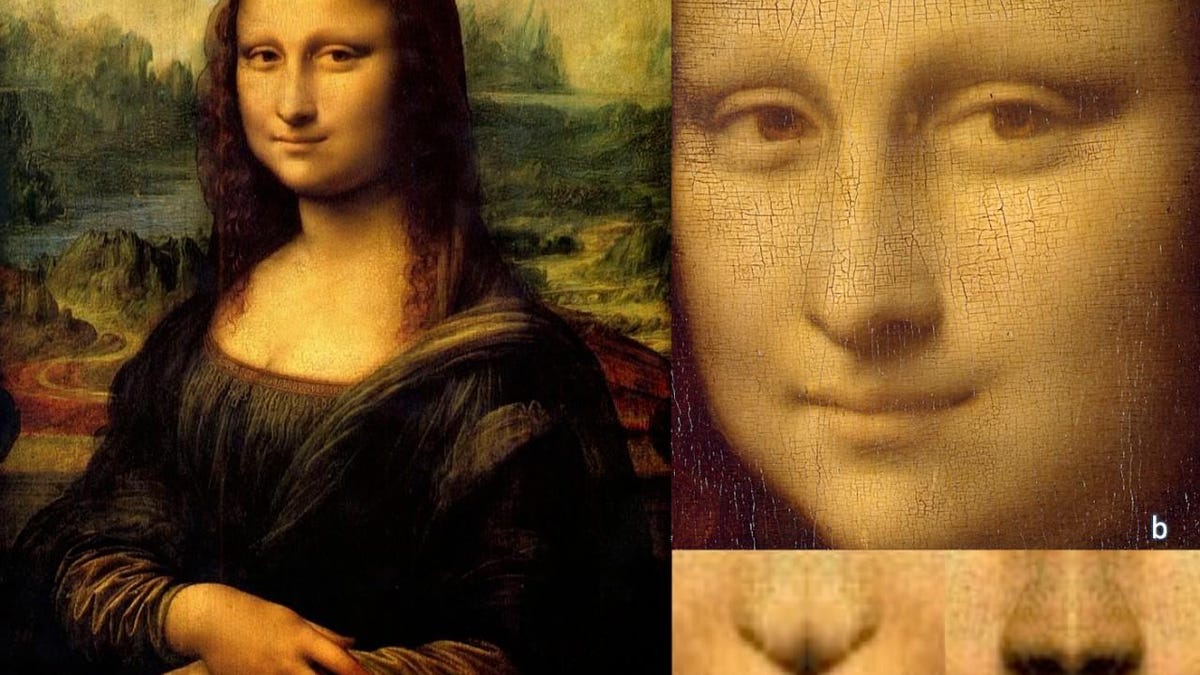Mona Lisa's smile could be a lie, neuroscientists say
If you had to sit still for hours, you might not be able to muster a genuine smile either.

The famed Mona Lisa (Musee du Louvre, Paris). B: The face of Mona Lisa C: Chimeric image of the left side of the Mona Lisa smile. D: Chimeric image of the right side of the Mona Lisa smile.
Mona Lisa's smile, possibly the most widely observed and scrutinized grin in history, might just be a "lie," scientists say.
An international team of researchers examined the symmetry of the subject's lips and the muscles in her upper face to conclude that the woman in Leonardo da Vinci's famed 16th century Renaissance portrait probably wasn't smiling in a happy sort of way, as the most recent interpretations of the painting have suggested.
Scholars and art observers have long been fascinated with the identity of the model in the painting and the emotions conveyed by her elusive smirk. Some have suggested asymmetry in her smile could be due to a weakening of the face from a medical condition like Bell's palsy. But the latest analysis looks at the model's asymmetrical expression from the perspective of neuropsychology.
"According to some influent theories of emotion neuropsychology, we interpreted the Mona Lisa asymmetric smile as a non-genuine smile, also thought to occur when the subject lies," the team writes in their study, titled "Unraveling the asymmetry of Mona Lisa smile." The research appears in a recent issue of the journal Cortex, which is devoted to the study of cognition and the relationship between the nervous system and mental processes.
Of course, "lie" might be a strong word here. The scientists acknowledge how unlikely it is that someone asked to sit still for hours can maintain a genuinely happy smile the whole time, even with all of the work Leonardo's jesters were known to have put in to keeping his models entertained as they posed.
The researchers include Dr. Luca Marsili, a neurologist from the University of Cincinnati College of Medicine; Dr. Lucia Ricciardi of St. George's University in London; and Matteo Bologna of Sapienza University in Rome. Their work reflects the enduring enchantment with one of the world's most famous paintings, and the way technology has increasingly led to more in-depth and nuanced insights into classic works of art.
We'll probably never know exactly what the Mona Lisa model was thinking, but it is intriguing to ponder the possibilities.
The study's authors asked a small sampling of 42 people to look at chimeric, or mirror, images of both sides of Mona Lisa's smile and attach emotions to them. Thirty-nine, or 92.8%, of the raters said the left half of the smile, which curves upward a bit, displayed happiness, but none said the same of the right side. Thirty-five perceived the right-side smile as neutral, five said it was disgust and two indicated sadness.
The study authors also note that the muscles in Mona Lisa's upper face aren't activated in the painting. A genuine smile that causes the cheeks to raise and muscles around the eyes to contract is called a Duchenne smile, named after 19th-century French neurologist Guillaume Duchenne.
Mona Lisa, up close. Past studies have focused on her eyes too.
The asymmetric smile, also known as a non-Duchenne smile, "reflects a non-genuine emotion and is thought to occur when the subject lies," note the authors, who suggest the idea da Vinci may have specifically asked Lisa for a crooked smile.
"An alternative intriguing possibility," advances the study in Cortex, "is that Leonardo already knew the true meaning of asymmetric smile more than three centuries before Duchenne's reports and deliberately illustrated a smile expressing a 'non-felt' emotion."
If da Vinci did in fact understand what asymmetric smiles convey, the authors speculate Mona Lisa's smile might hide cryptic messages that it was a self-portrait or that the portrait referred to a man or a dead woman. This builds on past theories that the painting contains latent symbols.
This isn't the first time science has turned its gaze on the Mona Lisa. Earlier this year German scientists debunked the famous concept that Mona Lisa's eyes track viewers moving in front of the painting housed at the Louvre museum in Paris. That's known as the Mona Lisa Effect.
"We conclude from the measurements that the lack of evidence is due to the claim being objectively false," they concluded. "Mona Lisa does not gaze at the viewer."
Somewhere the model at the center of the Mona Lisa is smiling at all the attention she continues to get all these years later. Though I wonder how she'd feel about the deepfake AI that turned her portrait into fabricated video?

